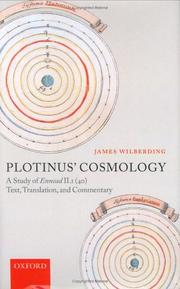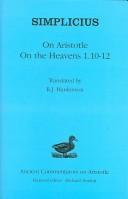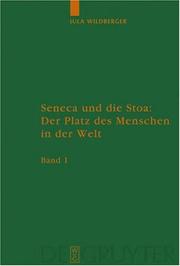| Listing 1 - 4 of 4 |
Sort by
|

ISBN: 3039106597 9783039106592 Year: 2006 Volume: 5 Publisher: Bern: Peter Lang,
Abstract | Keywords | Export | Availability | Bookmark
 Loading...
Loading...Choose an application
- Reference Manager
- EndNote
- RefWorks (Direct export to RefWorks)
Cosmology, Ancient --- Ancient cosmology --- Empedocles --- Empédocle --- Empedokles --- Criticism and interpretation. --- Cosmology, Ancient. --- Cosmologie antique --- Acqui 2006

ISBN: 0199277265 9780199277261 Year: 2006 Publisher: Oxford: Oxford university press,
Abstract | Keywords | Export | Availability | Bookmark
 Loading...
Loading...Choose an application
- Reference Manager
- EndNote
- RefWorks (Direct export to RefWorks)
In Ennead II.1 (40) Plotinus is primarily concerned to argue for the everlastingness of the universe, the heavens, and the heavenly bodies as individual substances. Here he must grapple both with the philosophical issue of personal identity through time and with the rich tradition of cosmology which pitted the Platonists against the Aristotelians and Stoics. What results is a historically informed cosmological sketch explaining the constitution of the heavens as well as sublunar and celestial motion. This book contains an extensive introduction aimed at providing the necessary background in Platonic, Aristotelian, and Stoic cosmology, the text itself, and a line-by-line commentary designed to elucidate its philosophical, philological and historical details.
Cosmology, Ancient. --- Cosmology --- Cosmologie antique --- Cosmologie --- Early works to 1800 --- Ouvrages avant 1800 --- Plotinus. --- Cosmology, Ancient --- Ancient cosmology

ISBN: 9781472557438 1472557433 9780725632321 9781472501370 0715632329 9780715632321 9781472557841 1472557859 9781472557414 9781472557377 1472557417 1472557379 9781472557957 9781472558121 9781472557858 1472557913 147255812X 1472557840 9781472557919 1472557956 9780715630709 9780715638446 9780715633427 9780715638439 0715638432 Year: 2006 Publisher: London Duckworth
Abstract | Keywords | Export | Availability | Bookmark
 Loading...
Loading...Choose an application
- Reference Manager
- EndNote
- RefWorks (Direct export to RefWorks)
"Aristotle believed that the outermost stars are carried round us on a transparent sphere. There are directions in the universe and a preferred direction of rotation. The sun moon and planets are carried on different revolving spheres. The spheres and celestial bodies are composed of an everlasting fifth element, which has none of the ordinary contrary properties like heat and cold which could destroy it, but only the facility for uniform rotation. But this creates problems as to how the heavenly bodies create light, and, in the case of the sun, heat. The topics covered in this part of Simplicius' commentary are the speeds and distances of the stars; that the stars are spherical; why the sun and moon have fewer motions than the other five planets; why the sphere of the fixed stars contains so many stars whereas the other heavenly spheres contain no more than one (Simplicius has a long excursus on planetary theory in his commentary on this chapter); discussion of people's views on the position, motion or rest, shape, and size of the earth; that the earth is a relatively small sphere at rest in the centre of the cosmos."--Bloomsbury Publishing.
Cosmologie antique --- Astronomie antique --- Mécanique céleste --- Aristote, --- Cosmology, Ancient. --- Physics --- Aristotle. --- Aristotle. De caelo. 1.10-12. --- Cosmology -- Early works to 1800. --- Aristotle --- Cosmologie antique. --- Astronomie antique. --- Mécanique céleste. --- Aristote --- Cosmology, Ancient --- Celestial mechanics --- Astronomy, Greek --- Astronomy, Ancient --- Cosmology - Early works to 1800 --- Motion --- Science, Ancient --- Four elements (Philosophy) --- Logic --- Cosmology --- Astronomy --- Astronomy, Ancient. --- Astronomy. --- Cosmology. --- Aristoteles, --- Aristoteles. --- De caelo (Aristotle). --- Geschichte 550. --- Philosophy of nature

ISSN: 18621112 ISBN: 3110191482 9783110191486 3110915634 Year: 2006 Volume: 84 Publisher: Berlin: de Gruyter,
Abstract | Keywords | Export | Availability | Bookmark
 Loading...
Loading...Choose an application
- Reference Manager
- EndNote
- RefWorks (Direct export to RefWorks)
Senecas Prosawerke als Schriften eines Stoikers zu erschließen und in den Kontext des stoischen Systems zu stellen - diese Aufgabe unternimmt Jula Wildberger mit der seit langer Zeit ersten detaillierten und ausführlichen Gesamt- und Neuinterpretation der stoischen Physik. In einer thematisch strukturierten Rekonstruktion beschreibt sie den stoischen Kosmos erstmals konsequent als ein Gebilde aus zwei dreidimensionalen Körpern und interpretiert vor allem die Mischungs- und Elementlehre sowie die Ontologie neu, während die Neusichtung der Quellen an anderen Stellen zu Präzisierungen und Ergänzungen führt. Behandelt werden neben diesen Themen der Physik und Kosmologie auch zahlreiche andere Bereiche der stoischen Philosophie: Logik, Sprachphilosophie, Theologie, Theodizee, Determinismus und Handlungsfreiheit. Jula Wildberger analysiert bei Seneca aufgespürte Theoriestücke und ordnet sie in die Gesamtrekonstruktion ein. Sie weist nach, dass Seneca trotz eigener Schwerpunkte im Rahmen der Orthodoxie mit oft überraschender theoretischer Tiefe operiert. Fehlt eine Communis opinio, entwickelt er differenzierte, eigenständige Antworten. Auch findet man neue, vorher nicht belegte Beiträge. Der monographische Haupttext kann auch als Einführung gelesen werden. Register, Querverweise und Anmerkungen mit ausführlichen Quellenzitaten und bibliographischen Hinweisen erlauben die Benutzung als Handbuch und Nachschlagewerk.
Philosophical anthropology. --- Cosmology, Ancient. --- Anthropologie philosophique --- Cosmologie antique --- Seneca, Lucius Annaeus, --- Stoics. --- Stoics --- Ethics --- Philosophy, Ancient --- Seneca, Lucius Annaeus --- Sénèque --- Seneca --- Annaeus Seneca, Lucius, --- Seneca, Annaeus, --- Seneca, --- Seneca, L. A. --- Seneca, Lucio Anneo, --- Seneka, --- Seneka, L. Annėĭ, --- Sénèque, --- סנקא, לוציוס אנאוס --- Pseudo-Seneca --- Seneca, Lucius Annaeus, - ca. 4 B.C.-65 A.D. --- Ancient philosophy, ancient natural philosophy, ancient theology, Seneca, Stoicism.
| Listing 1 - 4 of 4 |
Sort by
|

 Search
Search Feedback
Feedback About UniCat
About UniCat  Help
Help News
News